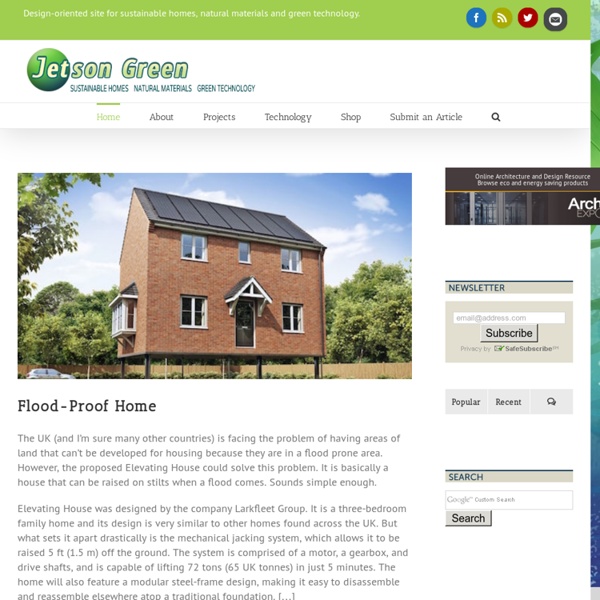



What Does Living Off The Grid Mean to You? - Living Off The Grid One thing I’ve noticed since starting this website is that there’s living off the grid and there’s Living Off The Grid. What do I mean by that? To me, at least when I first started writing about off grid topics, to “live off the grid” simply meant to have a home that wasn’t connected to the electricity grid. In other words, to have a battery backed-up solar, hydro or wind power system. Then I learned about people who were getting electricity by charging batteries using a generator once a week. I thought that was hardcore, but then I heard from folks who didn’t even have a generator, and were cooking with wood, lighting with oil and doing, literally, everything by hand.
Composting toilet Public composting toilet facility on E6 highway in Sweden A composting toilet is a dry toilet that uses a predominantly aerobic processing system that treats excreta, typically with no water or small volumes of flush water, via composting or managed aerobic decomposition.[1] Composting toilets may be used as an alternative to flush toilets in situations where there is no suitable water supply or waste treatment facility available or to capture nutrients in human excreta as humanure. They are in use in many of the roadside facilities in Sweden and in national parks in both the United States and the United Kingdom. The human excrement is normally mixed with sawdust, coconut coir or peat moss to support aerobic processing, absorb liquids, and to reduce the odor. The decomposition process is generally faster than the anaerobic decomposition used in wet sewage treatment systems such as septic tanks. Operating process[edit]
BMW Guggenheim Lab The BMW Guggenheim Lab shares insights on architecture, urbanism, design, technology, and more. Lab | Log Photo: Paul Warchol © 2011 Solomon R. Guggenheim Foundation, New York BMW Guggenheim Lab curator Maria Nicanor shares concluding thoughts on the Lab project, its achievements, and how its experience will affect the Guggenheim's architecture and urbanism programming in the future.
Eco Friendly Living Tips from Green House Wind turbines sit atop new houses that utilize 20% renewable energy on Nov. 25, 2009, in Croydon, England. The United Kingdom ranked first among 12 large economies for energy efficiency, according to a scorecard released Thursday by the private American Council for an Energy-Efficient Economy. The United States ranked ninth, right behind China. By Peter Macdiarmid, Getty Images Americans have long been known as the world's energy guzzlers for their supersized lifestyles. Living Off the Grid: How to Generate Your Own Electricity Our off the grid house near Anaconda, Montana Taking the Alternative Energy Plunge When my wife and I moved to Montana last year, we found a comfortable home on several acres with a view of the mountains. There was only one hitch – the house was off the grid. In fact, everyone in the subdivision generated their own power, including the bed and breakfast nearby. That doesn’t mean it was primitive.
Centre for Interactive Research on Sustainability CIRS is a space for multidisciplinary education and research, and though it’s one of the greenest buildings on earth, living within the resources and energy flow available on the site and surroundings, its goal is to become the baseline which future buildings will surpass. Rather than simply reducing its environmental impact, CIRS enriches its environment by making use of resources that would otherwise go unused. CIRS sources energy from the ground and scavenges heat from neighbouring buildings, generates electricity from the sun, obtains ventilation from the wind and harvests its water from the rain. Utilizing new technologies, CIRS also returns energy and water back to its surroundings. With its sustainable wood structure, large glass windows and living green walls and roof, the stunning four-story CIRS exterior blends harmoniously with the west coast beauty of the UBC campus. It is a short walk from trails that meander down forested cliffs to the ocean and beaches.
2012 TED Prize Winner Announced! For the first time in history, the TED Prize winner is not an individual, but an idea that greatly impacts the future of planet Earth… and the winner is The City 2.0. The City 2.0 is the city of the future, a future in which more than ten billion people are dependent on. The idea is not a “sterile utopian dream” but rather a “real-world upgrade tapping into humanity’s collective wisdom.” Outside the box: Celebrating the shipping container in architecture The widespread use of the modern metal shipping container can be traced back to the mid-1950's. According to Marc Levinson, in April 1956 an oil tanker traveled between Newark and Houston with 58 rudimentary "shipping containers," (actually refitted aluminum truck bodies) sparking a modern revolution in moving goods around the world. However, an unexpected result also eventually transpired: shipping containers became recognized as an attractive building material by many architects.
Sveriges mest eftersökta hem Within reach for most Swedes One of Sweden's most recognised architectural firms, Tham & Videgård, have transformed Hemnet’s data into a beautiful, contemporary and functional home. Tham & Videgård have drawn inspiration from two building types that stand out in Swedish building history: the ‘Falu red’ wooden cottage that represents a tradition of craftmanship, local resources and carpentry - and the rational functionalist box, which stands for modernity, function, the future, industrial development and international ideals. ”The result is a combination of the two types of buildings.